|
|
Hermit

|
|
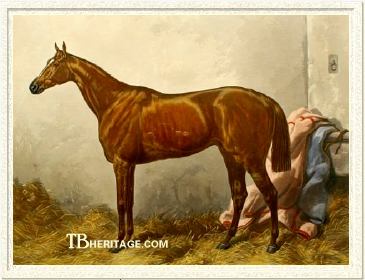 |
|
|
Hermit's story is one of the more colorful tales regarding nineteenth century British thoroughbreds. His victory in the Derby at Epsom was noted for its drama--of being run in a snowstorm and also for the fact that it led to the financial ruin of a member of the aristocracy, a man who had earlier eloped with the fiancee of Hermit's owner. Yet Hermit was a popular colt with the racing public, and he went on to become an important and influential stallion.
Hermit was a small, blaze-faced chestnut with a delicate constitution. His sire, Newminster, was a beautifully bred individual, being by Touchstone, sire of eight classic winners, and out of the extraordinary race mare Bee's Wing. Newminster was a full brother to Two Thousand Guineas winner and St. Leger runner-up Nunnykirk. As a racehorse, Newminster could be described as disappointing, as his only major victory came in the St. Leger. However, he had a number of excuses, for Newminster was an animal plagued with physical ailments, including bad feet and dental problems. At stud, he more than made up for disappointments on the turf. He was leading sire in Britain in 1859 and 1863, and even before Hermit was foaled, Newminster had sired three classic winners--Derby champion Musjid; One Thousand Guineas victress Nemesis; and St. Leger winner and Derby runner-up Lord Clifden.
While Hermit's pedigree on his sire's side was patrician, his dam's family was positively plebeian. His dam, Seclusion, who won six races worth £2,215, came from a family which had not produced an animal of quality for many generations. Prior to foaling Hermit, Seclusion had not produced anything of any merit. Later, she became the dam of Steppe, a minor stakes winning filly which placed second in the One Thousand Guineas. Seclusion's 1869 daughter, Louise, by Marsyas, won three Queen's Plate races, and Seclusion's unraced daughter Fair Rosamond, by King John, produced a One Thousand Guineas winner in the Statesman filly Elizabeth. Much later Seclusion's female family was represented by good racehorse and French leading sire Apelle (1923), whose sixth dam was the aforementioned Elizabeth, and the fine stayer and dual English leading sire Son-in-Law (1911), whose fourth dam was Seclusion's daughter Reticence.
Hermit was, despite his small size, a handsome and well-proportioned colt. He was bred by William Blenkiron at Middle Park Stud, and sold as a yearling at Blenkiron's annual sale. Hermit was knocked down to Henry (later Viscount) Chaplin for 1000 guineas, and was then sent to Bedford Cottage, the Newmarket yard of brothers Charles and George Bloss. However, many of the decisions regarding Hermit's racing career were made by Captain James "Jem" Machell, the manager of Chaplin's horses, who had a part interest in Bedford Cottage.
Hermit on the Turf
As a juvenile, Hermit showed that he was a colt with a good deal of talent. He narrowly lost his debut at Newmarket to another offspring of Newminster, the filly Cellina. In his next race, the Biennial Stakes, held at the meeting of Somerset and Bath, Hermit turned the tables on Cellina and beat her by a neck. The Newminster colt ran into a tremendously talented opponent in his next start, the Woodcote Stakes at Epsom. That was the filly Achievement, a daughter of Stockwell and a full sister to Triple Crown winner Lord Lyon; over the course of the season she would rack up eleven wins in thirteen starts. Hermit finished second to her, a good indication of his class, given that Achievement was widely considered to be one of the most brilliant two-year-olds of the season.
Following the Woodcote, Hermit won three races in succession -- a Biennial Stakes at Ascot, a Biennial at Stockbridge, and the Troy Stakes, also at Stockbridge. He had won four of his six juvenile races, and went into winter quarters as a promising candidate for the next season's classic races.
The Romance, the Scandal, the Upset
Hermit's three-year-old season was made all the more interesting by the saga of the humans involved. Hermit's owner, Henry Chaplin, was at the time a young man in his mid-twenties, as was his one-time close friend, Henry Hastings, 4th Marquess of Hastings. The latter had inherited a fortune when he came of age in 1863, and used the money for expensive thoroughbred purchases and even more costly gambling wagers. Hastings was recklessly extravagent, negligent in his business affairs, and self-indulgent, his life later used as a cautionary tale regarding the combination of huge sums of money and the perils associated with the turf. His gambling was one factor that set him on the road to financial ruin, and Hermit's run in the Derby played a pivotal role in this saga.
Henry Chaplin was betrothed to Lady Florence Paget in 1864, but the young woman had other ideas, and just before the wedding she eloped with Hastings, leaving Chaplin the embarrassed victim of one of the juiciest scandals London had seen for a long while. In the following several years, both Chaplin and Hastings became increasingly involved in racing. Hastings' horse, Ackworth had a big win the Cambridgeshire of 1864, and his colt Lecturer won the Cesarewitch of 1866 while his owner won £70,000, although he apparently carelessly allowed a number of bets he made on his horse go uncollected. Chaplin, in the wake of his abandonment at the alter, "...bought horses as if he was drunk and betted as if he was mad." He spent a great deal of money to purchase the Stockwell - Blink Bonny colt, Breadalbane, a full brother to Derby winner Blair Athol, and his near-relation the Stockwell - Queen Mary colt Broomielaw, both born in 1862, apparently with an eye to challenging Hastings' Stockwell colt, The Duke, in the 1865 Derby. That ended up being the French horse, Gladiateur's Derby. In the 1867 Derby, this intermittantly fierce, but generally gentlemanly competition came to a head.
Hermit did not run in the 1867 Two Thousand Guineas, the story being that Captain Machell wanted to win it with his own horse, Knight of the Garter, and Chaplin obligingly withheld Hermit. Knight of the Garter finished second to Vauban. So Hermit was trained up to the Derby, his first start of the season. Only a fortnight before the race, during a gallop, Hermit almost collapsed after breaking a blood vessel.
Hermit was prone to breaking blood vessels, a weakness inherited from his both his sire and dam. Newminster had several offspring afflicted with the problem, while Hermit's dam had broken a blood vessel while contesting the Yorkshire Oaks.
It seemed that Hermit would have to be withdrawn from the Derby, but Machell, keeping in mind Hermit had beaten Vauban the previous season, and that he had beaten Knight of the Garter in trials, was not ready to declare Hermit from the race. Instead, for the next two weeks, he kept Hermit stallbound with his head tied up in the air, ostensibly to lessen the blood pressure near the vessels of the colt's nose. He also worked the horse going downhill for the same purpose. For whatever reason, Hermit worked very well only a few days before the race was run, but his disasterous bleeding in the earlier gallop was already well-known among turf spectators and gamblers.
The day of the race was cold and dark, with a heavy snow falling steadily, and poor Hermit looked particularly miserable, shivering as his rug was pulled off; his odds were 1,000 to 15, even with his encouraging gallop a few days earlier. There were thirty runners, among them Uncas, who belonged to Hastings, and The Rake (by Wild Dayrell), who had been favorite until just a few days before, when he, too, broke blood vessels when exercising. Ten false starts delayed the race for nearly an hour. After the field finally broke, Two Thousand Guineas champion Vauban and a colt named Marksman were always forwardly placed, and were still going strong near the finish. The 20 year old jockey, John Daley followed Machell's instructions exactly on Hermit, moving him to the outside for a long, sustained run, and the little chestnut got up to win the race by a neck with Marksman second and Vauban third. The colt belonging to the Marquess of Hastings, Uncas, and the former favorite, The Rake, finished far down the course.
Chaplin and Machell, who had laid huge wagers on Hermit, won a fortune. Hastings, on the other hand, lost over £100,000 in wagers, and he further owed Hermit's owner £20,000 as a result of his bets. Chaplin told him to delay payment on the sum owed him until it was convenient.
The saga of Henry Chaplin and the Marquess of Hastings ended a little over a year after Hermit's Derby victory. Hastings recouped some money through wagers a short time after the Derby, but lost everything the next spring, when his filly, Lady Elizabeth, was badly beaten in the Derby, a race she should not have contested, having been overun and ruined in her brilliant two year old year. Already in serious financial difficulties and enmeshed in the shady dealings of vicious moneylenders who haunted the turf, this Derby and the courageous filly's try at the Oaks, where her owner was hissed for using her so badly, signalled complete ruin for Hastings, even though his horse, The Earl had won the Grand Prix in France and several races at Ascot. He died a few months later at the age of 26. His last words were, "Hermit's Derby broke my heart. But I did not show it, did I?" A sad irony is that Hastings might have won the Derby with Hermit, as he was the underbidder to Henry Chaplin that summer day three years previously when the yearling Hermit went through the auction ring at Middle Park Stud.
Following Hermit's Derby win, Henry Chaplin reduced his involvement in racing, although he maintained his stud at Blankney Hall in Lincolnshire, which he had inherited with other estates when he was 21. In 1876 he married Lady Florence Gower, and he maintained an active life in politics and as master of the Blankney Hunt for some years. In 1892, facing reduced income from his estates, he sold Blankney, but continued to be a well-known figure in sporting circles; he was raised to the peerage in 1916. And Lady Florence Paget Hastings? She remarried Sir George Chetwynd, who was a professional punter, despite his membership in the Jockey Club and his position as a Steward of the Club. In 1887 Chetwynd was a principal in a libel suit, later submitted to arbitration by racing "experts," when he was publicly accused of consistently having his horses pulled. While he won the arbitration, he was awarded a single farthing in resolution and subsequently retired from the turf.
Hermit's Subsequent Turf Career
Hermit kept his Derby form at Ascot, capturing the Biennial Stakes and the one mile St. James Palace Stakes on successive days. He did not start again until the Doncaster meeting and the final of the classics, the St. Leger. In that race, Hermit finished second to Achievement. That brilliant filly had won several races on the season, including the One Thousand Guineas and the Coronation Stakes. But those races were at a mile, and she silenced doubts about her stamina by easily defeating Hermit over the 1-3/4 miles of the St. Leger course. Achievement disposed of Vauban, the Two Thousand Guineas champion, and held off Hermit by a length, with Julius only a head behind Hermit in third. The next day, Hermit and Achievement crossed swords again, in the Doncaster Cup, run over the same distance, with the same results. Hermit had the advantage nearing the finish, but the filly ranged alongside. They raced in tandem for a few strides before Achievement pulled ahead to win easily. Later in the same day, Hermit won a 1-3/4 mile sweepstakes over the St. Leger distance, giving him a victory and two seconds and a total of over six miles run in the space of just two days.
But his two autumn performances against Achievement were arguably the best of his career. They were two exceptional animals, easily the best of their generation, and they waged dramatic runs during those two afternoons at Doncaster. All told, Hermit and Colonel Pearson's filly Achievement faced each other three times, the filly emerging victorious on each occasion. It was a tragedy that Achievement died at a very young age, without ever producing a recorded live foal.
|
|
Hermit's Race Record |
| Year |
Age |
Starts |
1st |
2nd |
3rd |
Unplaced |
| 1866 |
2 |
6 |
4 |
2 |
0 |
0 |
| 1867 |
3 |
9 |
4 |
2 |
0 |
0 |
| 1868 |
4 |
5 |
0 |
2 |
0 |
3 |
| Total |
-- |
20 |
8 |
9 |
0 |
3 |
| |
Thereafter, Hermit's career upon the turf was anticlimactic. He seemed to have lost his brilliance. In his three remaining races at three, Hermit finished second on each occasion, beaten twice by Fripponier to whom he gave seven pounds both times, and by Longchamps in the Newmarket Derby, to whom he gave 14 pounds.
|
Hermit raced five times at four, but failed to win a single race, although in two of them he gave away gobs of weight to the rest of the field. The best he could do that year was a second in the Newmarket Biennial Stakes, when he was beaten by a half-length by Julius.
Hermit in the Stud
Hermit's stud career started out with a fee of twenty guineas, which eventually rose to 300 guineas. Hermit began with a tiny initial crop of six foals, and then went on to become an astounding success, becoming one of the most popular and fashionable stallions of his time. He was leading sire in Britain seven years in succession, 1880-1886. Hermit's fillies, especially, were treasures; four of his five classic winners were fillies, and he was in the top ten in the broodmare sire lists in England for sixteen years.
|
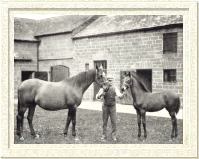
Shotover in the stud with a St. Simon filly
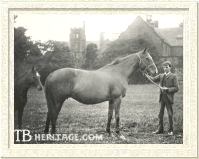
St. Marguerite in the stud with filly St. Marina
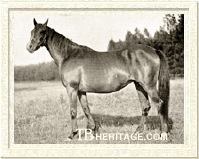
Lonely
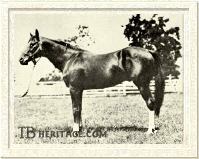
St. Blaise was sent to the Belmont stud in the U.S.
| |
Hermit's English classic winners were as follows:
THEBAIS (1878), chestnut filly out of Devotion, by Stockwell. She captured the One Thousand Guineas, the Oaks, Yorkshire Oaks, Ascot Gold Vase, Liverpool Autumn Cup, dead-heated for the Champion Stakes and walked over for the Epsom Gold Cup. In-bred 3 x 3 to Touchstone.
ST. MARGUERITE (1879), chestnut filly out of Devotion, by Stockwell. This full sister to Thebais captured the One Thousand Guineas and was second in the Oaks. As a broodmare, she produced Roquebrune (by St. Simon), dam of Triple Crown champion and major sire Rock Sand. St. Marguerite also was the dam of St. Marina (by Janissary), the fourth dam of American Triple Crown winner Gallant Fox. St. Marguerite's daughter Seabreeze, by Isonomy, won the Oaks and St. Leger and was second in the One Thousand Guineas.
SHOTOVER (1879), chestnut filly out of Stray Shot, by Toxophilite. Shotover captured the Two Thousand Guineas and the Derby and was third in the St. Leger. As a broodmare, she became the third dam of influential broodmare Frizette. In-bred 3 x 4 to Touchstone.
LONELY (1882), bay filly out of Anonyma, by Stockwell. She won the Oaks and ran third in the St. Leger. She later produced Prisoner (1890, by Isonomy), a winner of the Doncaster Cup, and several winning daughters, including Saintly (1892, by St. Simon), a good juvenile winner of the National Stakes and Woodcote Stakes, and Ice Maiden (1899, by Kendal), who won the Yorkshire Oaks, Ascot Gold Vase, and other races. LONELY'S tail-female line includes the AJC and Victoria Derby winner and leading Australian sire, Malster (1897); stakes winner My Dear Girl (1957) and her stakes-winning son and important sire In Reality (1964); Derby Italiano and Grosser Preis von Baden winner Glint of Gold (1978) and his brother, Diamond Shoal (1979), a stakes winner in France, Italy and Germany, and numerous other high-class winners.
ST. BLAISE (1880), chestnut colt out of Fusee, by Marsyas. ST. BLAISE captured the Epsom Derby in 1883. Purchased by August Belmont for stud duty, he was leading sire in the US in 1890. One of his best offspring was the dual-champion colt Potomac, out of champion mare Susquehanna. Potomac won the Futurity Stakes. ST. BLAISE also sired such good ones as St. Carlo, St. Bartholomew, Fond Hopes, Margrave (a winner of the Preakness), the dual-champion La Tosca, a winner of the Fashion Stakes, and Her Highness, a winner of the Monmouth Oaks.
|
After Belmont's death in 1890, ST. BLAISE came up for auction by the estate's executors. The chestnut stallion realized $100,000, at the time, the most ever paid for a horse at public auction. The purchaser was Charles Reed, master of Fairview Stud in Tennessee. ST. BLAISE was not a success there, and was several years later purchased by James Ben Ali Haggin, who re-located the horse to Kentucky. August Belmont II then acquired the old horse and pensioned him at Nursery Stud in Kentucky, where St. Blaise died at the age of 29. Inbred 3 x 4 to Touchstone.
Three of Hermit's five classic champions were out of daughters Stockwell, as was Hermit's top class son, TRISTAN (1878). The latter was a tough, but bad-tempered horse out of Stockwell's daughter, Thrift. Tristan ran twenty-five times in his career, and accounted for such prestigious races as the Ascot Gold Cup, the July Cup, the Epsom Gold Cup (twice), the Hardwicke Stakes (three times), and the Champion Stakes (three times). As a stallion, TRISTAN is famed as the sire of Canterbury Pilgrim, a daughter of classic-winning mare Pilgrimage, and dam herself of the leading sires Chaucer (by St. Simon) and Swynford (by John o' Gaunt). |
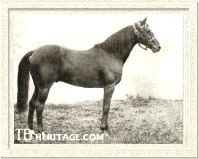
Hermit's best racing son, Tristan
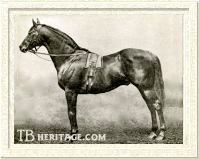
Unbeated juvenile Friar's Balsam sired Voter.
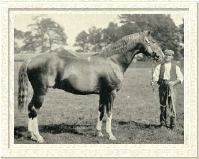
Hazelhatch was a winner
| |
Another good son of Hermit was the chestnut colt FRIAR'S BALSAM (1885), produced from the Breadalbane mare, Flower of Dorset. Again, Stockwell was in the mix, as he was the sire of Breadalbane. FRIAR'S BALSAM was a brilliant two-year-old, unbeaten in seven races, and easily handled the best of his generation, including the filly Seabreeze and the Hampton colt Ayrshire, both of whom went on to win classics the next season. Friar's Balsam suffered from a mouth abcess as a three-year-old which burst during the running of the Two Thousand Guineas won by Ayrshire. The colt was never the same after that, though he did win the Champion Stakes over Minting as a four-year-old.
At stud, FRIAR'S BALSAM sired Voter, imported by James Keene to the United States. As a stallion, Voter sired Runnymede, whose son Morvich won the Kentucky Derby, and Ballot, sire of many stakes winners. Friar's Balsam also sired the filly Mother Siegel, whose son by Cyllene, Minoru, captured the Two Thousand Guineas and the Derby for King Edward VII in 1909. Minoru left behind the filly Serenissima, destined to become the second dam of Derby champion and major sire Hyperion.
Hermit's son TRAPPIST, out of Bunch, by Muscovite, was a good campaigner, with twenty-four victories to his credit. At stud, he sired one exceptional individual, Lord Randolph Churchill's black Oaks heroine L'Abbesse de Jouarre, who later became the dam Desmond, a high class racing son of St. Simon and leading sire in Britain in 1913.
HAZELHATCH, out of Hazeldean by Cathedral, and in-bred to Newminster, was a sturdy winner of six of seventeen races. At stud he got the non-winning Eryholme, dam of the tough mare Anchora that later became the dam of Scapa Flow.
ASCETIC, out of Lady Alicia by Melbourne, was useless on the racecourse, but in Ireland became the dominant sire of steeplechasers and hurdlers in the U.K. for almost twenty years; his offspring included three Grand National winners, and two daughters produced Grand National winners.
|
|
Hermit's male line did not survive in England, but it thrived for a while in France and Argentina. ST. MIRIN (1883), out of Lady Paramount, by Brother to Stafford, wound up in Argentina and sired several nice winners there. Hermit's son, HEAUME (1887), out of Bella, by Breadalbane (again a Stockwell influence), was a winner of the Prix du Jockey Club. His son, Le Roi Soleil, turned out to be a decent enough sire, as he came up with Sans Souci II, a winner of the Grand Prix de Paris in 1907, who later became a leading sire in France and grandsire of Bubbles, also a leading sire in France.
|
Hermit's Daughters
Hermit was especially prized for his daughters, for they were extraordinary producers. Some of the more important ones, in addition to the ST. MARGUERITE, SHOTOVER, and LONELY, include:
MOORHEN (1873), a dark bay daughter of the mare Sister to Ryshworth, she became the dam of Gallinule, a colt by Isonomy. Gallinule was an average sort on the track, he never competed in the classics and won only three races. But he became a first rate sire, his get including the brilliant filly Pretty Polly, as well as Slieve Gallion, White Eagle, Wildfowler, Hammerkop, and Sirenia.
EGLENTINE (1874), out of Mabille, by Parmesan, foaled Briar-root, a Springfield filly victorious in the One Thousand Guineas.
SUICIDE (1876), out of Ratcatcher's Daughter, was a crippled mare who never raced, but she became the dam of Amphion, a horse by Rosebery. A talented sprinter, Amphion at stud sired Sundridge, himself a major stallion with classic winners Jest and Sunstar to his credit. Foundation mare Lady Josephine was also sired by Sundridge.
REMORSE (1876), out of Vex, a full sister to Galopin. Remorse foaled McGee, who after his importation to the United States, became the sire of Exterminator, In Memoriam, and Donerail.
BELLA-DONNA (1885), out of Bonnie Doon, by Rapid Rhone, was imported by August Belmont for the Nursery Stud broodmare band. For Belmont, Bella-Donna foaled the extraordinary American racemare Beldame.
SECLUSION (1886), named after Hermit's mother, Seclusion became the dam of a filly by Janissary named Lock and Key. Purchased for the broodmare band of the Earl of Derby's stud, Lock and Key became the dam of Oaks winner Keystone II, and granddam of the St. Leger-winning filly Keysoe. French One Thousand Guineas victress The Nile also traced to Lock and Key. |
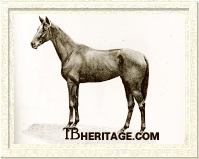
Alicante
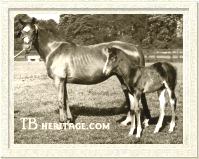
Astrology
| |
ALICANTE (1887), out of Madeira, by Thunderbolt, raced for Maruice Ephrussi, a well-known French sportsman. She had a brilliant juvenile career, taking five races in France: the Prix de La Toucques at Deauville, the Grand Critérium at Dieppe, the Grand Prix de Spa (worth 40,000 francs), the Prix de la Forêt, and the Prix de la Salamandre. In England she was third in the Lancashire Plate at Manchester. At age three she won the Prix du Nabob, the Prix Royal Oak and the Prix d'October in France, and the Cambridgeshire in England ("easily"), placing second in the Cesarewitch. She produced two fillies by Ephrussi's stallion War Dance that bred on through the mid-twentieth century.
ASTROLOGY (1887), out of Stella, by Brother to Stafford, became the dam of Star Shoot. Imported to the United States for stud purposes, and standing for a good deal of his life at John Madden's Hamburg Place outside Lexington, Star Shoot became both a leading sire and leading sire of broodmares. His best get were Triple Crown champion Sir Barton, and classic winner Grey Lag. Daughters of Star Shoot produced such notables as Crusader, Mars, Escoba, and The Finn. Astrology also produced a half-sister to Star Shoot, St. Celestra, who foaled a French Oaks winner in St. Astra. |
|
CINDERELLA (1888), out of Mazurka, by See-Saw, was another Hermit daughter imported into the U.S. She became a member of James R. Keene's broodmare band at Castleton Farm near Lexington, Kentucky. Her best offspring was the Commando colt Peter Pan, winner of the Belmont Stakes.
|
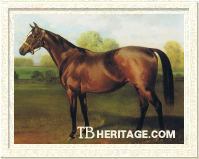
Priestess | |
PRIESTESS (1889), from an unnamed Lord Lyon mare, was half-sister to Mimi (by Barcaldine), a winner of the One Thousand Guineas and Epsom Oaks in 1891. She was bred at Sir Tatton Sykes's Sledmere Stud in Yorkshire and sold to SIr Joseph Blundell. In her only season at age two, she won four races, including the Somerville Stakes and the Prendergast Stakes at Newmarket. Bred to Blundell's stallion, Common, she produced that stallion's only classic winner, Nun Nicer, that took the One Thousand Guineas in 1898. She also was the dam of Nun Nicer's full brother, The Bishop, a winner of seven races. PRIESTESS died in 1908.
|
Hermit had several more daughters that were noteworthy. His classics-placed daughter NELLIE (1879) became the second dam of Derby winner St. Amant; DISTANT SHORE (1880) became the second dam of leading British sire Cyllene; DINAH (1871), a full sister to SUICIDE, became the second dam of Marcovil; NOVITIATE (1882) became the second dam of Marco, he the sire of Marcovil; and Hermit's daughter THE APPLE (1886) went on to found a family that has included Nellie Morse, Nellie Flag, Bull Lea, Forego, Saratoga Six, and Bold Forbes.
There was one negative aspect of Hermit's stud career, and that was that he, as a breaker of blood vessels, did pass that infirmity on to some of his descendants. His grandson Gallinule was probably the most noteworthy to suffer from the malady. The Derby winner of 1921, Humorist, carried three crosses of Hermit in the fifth generation of his pedigree. And while Hermit may have been far enough removed in his pedigree to be of little significance, the fact remains that Humorist, afflicted with a tubercular lung condition, had previously broken blood vessels and died from a massive lung hemorrhage two weeks after his Epsom triumph.
In 1883, at the height of his success as Britain's leading sire, Hermit was joined in the stallion boxes at Blankney by Galopin, purchased by Henry Chaplin after the death of Galopin's owner, Prince Batthyany. This gave Chaplin the distinction of having one of the most powerful stallion rosters in Britain.
Hermit, a very sweet-natured horse, was reputed to be so gentle that Chaplin could safely allow his small children to ride on the stallion's back. Hermit lived to be twenty-six, dying at Blankney in 1890.
--Elizabeth Martiniak
|
|
|
|

